 klaus-michael schneider
klaus-michael schneider
Keywords: education |
Links: FOTW homepage | search | disclaimer and copyright | write us | mirrors

Last modified: 2021-08-26 by  klaus-michael schneider
klaus-michael schneider
Keywords: education |
Links: FOTW homepage |
search |
disclaimer and copyright |
write us |
mirrors
See also:
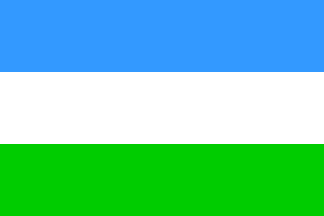 image by Ivan Sache, 02 December 2014
image by Ivan Sache, 02 December 2014
Institución Educativa Cecilia de Lleras was established in Monteria (Córdoba
Department) by Ordinance No. 21 of 25 May 1969.
The flag of the institute is described as diagonally divided indigo
blue-white-green. The upper, blue part and the lower, green part each form a
right-angled triangle.
Blue is a symbol of the sky covering the Sinú valley, supplying life and elation.
White is a symbol of frankness, determination and human feeling. Green is a
symbol of the fertility of the fields and of the vivacity of the youth.
However, the companion drawing shows the flag with horizontal stripes.
Source:
http://iececilialleras.edu.co/simbolos-de-la-institucion/ -
Institute's website
A photo seems to confirm the horizontal arrangement of the stripes.
http://iececiliadelleras2011.wikispaces.com/home
Ivan Sache, 02 December 2014
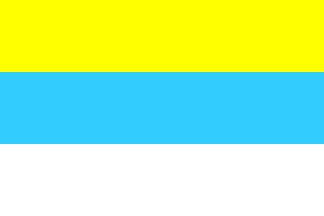 image by Ivan Sache, 6 January 2009
image by Ivan Sache, 6 January 2009
"Colegio CEDID San Pablo" was founded in 1988 in
Bosa, Bogotá.
The flag of the institute, as shown graphically on the website
of the institute, is horizontally divided yellow-light
blue-white.
Ivan Sache, 6 January 2009
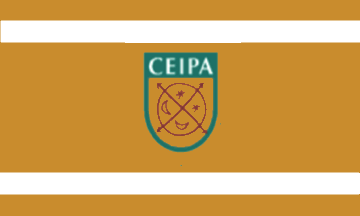 image by Ivan Sache, 14 Febuary 2004
image by Ivan Sache, 14 Febuary 2004
CEIPA is the 'Centro de Investigacion y Planeamiento
Administrativo'. It was founded in Medellin in 1972 by Antonio
Mazo Mejia and his wife. In 1992, the CEIPA was granted the
status of University Foundation.
The flag of CEIPA is yellow, for excellence, with two thin white
stripes, for transparency required for excellence in business, in
the upper and lower parts of the flag, and the shield of the
institute in the middle.
The shield of CEIPA is U-shaped, for University. The symbol
placed on the shield was used in the Middle Ages by merchants.
The four arrows symbolize the four compass directions, in which
commerce should spread, whereas the moon crescents and stars are
symbols of business. This medieval symbol was selected to recall
that both business and university concepts date back to the
Middle Ages.
Source: virtual.ceipa.edu.co>,
located by Dov Gutterman.
Ivan Sache, 14 Febuary 2004
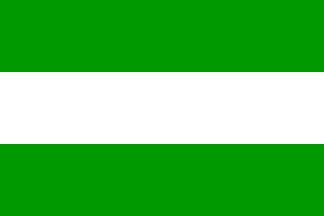 image by Ivan Sache, 3 February 2009
image by Ivan Sache, 3 February 2009
"Liceo 'Celedón'" was founded in Santa Marta,
Department of Magdalena, on 24 November 1905 (Decree No. 118).
Named after Rafael Celedón (1833-1902)), appointed Bishop of
Santa Marta in 1891, the institute was declared "National
Monument" on 17 December 1993 (National Decree No. 2529).
The flag of the institute, as described on the website
of the institute, is made of the two colours white and green.
The arrangement of the stripe is not detailed. The emblem of the
institute designed by Diomedez Varas shows on the shield's right
a flag horizontally divided green-white-green, presented as
"a flag, green and white symbolizing peace and hope".
White represents purity of heart and mind.
Green represents hope, strength and energy dedicated to study.
Ivan Sache, 3 February 2009
 image by Ivan Sache, 1 January 2021
image by Ivan Sache, 1 January 2021
Colegio Celestin Freinet, located in Chía (Cundinamarca), is named for the
French pedagogue and educational reformer Célestin Freinet (1896-1966), founder
of the Modern School Movement.
The flag of Colegio Celestin Freinet is
horizontally divided white-blue celeste-white.
Photos
https://www.facebook.com/Celfrechia/photos/?tab=album&;album_id=2366938636737205
Ivan Sache, 1 January 2021
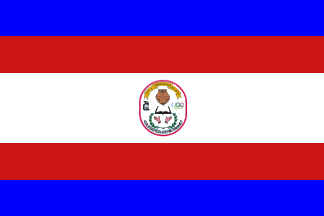 image by Ivan Sache, 1 January 2021
image by Ivan Sache, 1 January 2021
Colegio Celestin Freinet, located in Suba (Bogotá), is named for the French
pedagogue and educational reformer Célestin Freinet (1896-1966), founder of the
Modern School Movement.
The flag of Colegio Celestin Freinet is
horizontally divided blue-red-white-red blue (1:1:2:1:1) with the school's
emblem in the center.
Photos
https://celestinfreinet.edu.co/wp-content/uploads/2020/07/a4.jpg
https://twitter.com/OficialCCF/status/1124329058605633536/photo/1
Ivan Sache, 1 January 2021
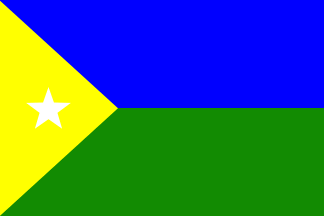 image by Ivan Sache, 3 January 2021
image by Ivan Sache, 3 January 2021
Institución Educativa Colegio Celestin Freinet, located in Itagüí
(Antioquia), is named for the French pedagogue and educational reformer Célestin
Freinet (1896-1866), founder of the Modern School Movement.
The flag of
IE Colegio Celestin Freinet is horizontally divided blue-green with a yellow
triangle placed along the hoist and charged with a yellow star.
Yellow is
a symbol of force.
Blue is a symbol of knowledge.
Green is a symbol of
hope.
The white star is a symbol of advice and guidance.
https://iecelestinfreinetitagui.edu.co/simbolos
School website
Ivan Sache, 3 January 2021
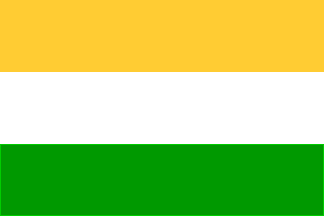 image by Ivan Sache, 18 November 2014
image by Ivan Sache, 18 November 2014
Institución Educativa Celmira Huertas was established in 1980 in Ibagué
(Tolima Department), as Escuela Séptima Etapa. The school was subsequently named
for Celmira Huertas, a teacher whose seven children became teachers, too.
The flag of the institute is horizontally divided orange-white-green.
Source:
http://www.iecelmirahuertas.com/?cat=9 - Institute's website
Ivan Sache, 18 November 2014
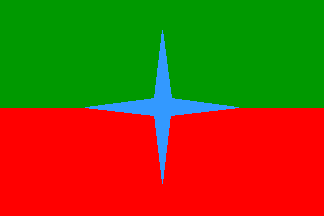 image by Ivan Sache, 12 July 2014
image by Ivan Sache, 12 July 2014
Escuela Leovigildo Gutiérrez was established in 1992 in the La Rosita
borough, part of the municipality of Villavicencio (Meta Department). Colegio
Centauros was established on 17 September 2002, merging Escuela Leovigildo
Gutiérrez with three other schools, located in La Cecilia (est. 1984), Juan
Pablo II (est. 1992) and Amor (est. 1990) boroughs, respectively.
The
flag of the institute is horizontally divided green-red with a blue four-pointed
star in the middle.
http://www.centauros.edu.co/simbolos.html - Institute's website
Ivan Sache, 12 July 2014
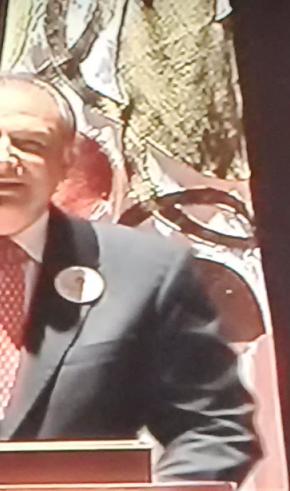 image located by Esteban Rivera, 08 November 2015
image located by Esteban Rivera, 08 November 2015
The Universidad Central flag has two versions:
one is a white horizontal flag with the logo (without inscription), and the
second version is the same horizontal white background with the logo in the
middle plus the University's name below in black capital letters.
Source:
http://www.ucentral.edu.co/index.php?option=com_content&view=article&id=106&Itemid=195
The flag can be seen in the following
picture. (First flag from left to right. Picture taken on June 2011 during a
speech by current Colombian Ombudsman Alejandro Ordóñez)
The Logo of the University is described
here. For further information go to:
Universidad Central (official
website)
Esteban Rivera, 06 June 2011
I'm attaching a sample of this flag (the first
version one, plain logo without inscription), during a speech by a government official at the Universidad Central aired on
August 5, 2015 but held the day before, August 4.
Source:
CM& news website
Also, the University's flag is seen in
this article
(flag on the left) about a reputed piano player giving a
concert on October 19, 2015
(article published on November 6). In the video, the flag is also
seen.
Source:
http://www.ucentral.edu.co/noticentral-uc/helvia-mendoza-homenaje-a-una-pianista-ejemplar
Esteban Rivera, 08 November 2015
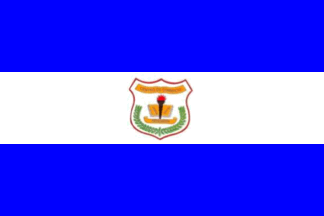 image by Ivan Sache, 14 July 2018
image by Ivan Sache, 14 July 2018
Institución Educativa Centro de Comercio de Piedecuesta (Santander
Department) was established by Resolution No. 12,506, issued on 28 October 2001,
as the merger of Centro Femenino de Comercio, Concentración Escolar Nuestra
Señora de la Presentación, and Jardín Infantil Nacional de Piedecuesta.
Centro Femenino de Comercio was established, as the girl's section of Colegio
Balbino García, by Order No. 7, issued on 25 November 1948, to be renamed to
Escola Normal Rural in 1953 and Colegio Oficial de Señoritas in 1964. The name
of Centro Femenino de Comercio was established by Resolution No. 6,648, issued
on 28 November 1974.
The flag of IE Centro de Comercio, horizontally
divided blue-white-blue with the institute's coat of arms in the center, is
described in Article 1B of the school's Manual de Convivencia, as follows:
Blue is connected with intelligence and conscience, and associated with
stability: thinking depth, loyalty, confidence, knowledge, faith, truth and the
eternal sky. Blue has a tranquilizing effect on mind and also represents peace,
balance and harmony.
White is associated with light, kindness, innocence and
purity. White is a symbol of perfection, safety, purity and limpidity;
considered as the color of perfection, it generally has a positive connotation.
In heraldry, white represents faith and purity.
For these reasons, the blue
and white colors of the flag of Centre de Comercio represent knowledge and
wisdom, truth, rectitude, values which are clearly involved on the development
of intelligence and the conscience of our educational community.
The coat
of arms of IE Centro de Comercio is described in Article 1A of the Manual de
Convivencia, as follows:
Basically, the chromatic elements that compose the
coat of arms of Centro de Comercio are white, yellow and green.
In the
heraldic language, yellow is called or while white is called argent, two
incorruptible ores whose shine and resistance symbolize nobleness and highest
ideals. Moreover, Centro de Comercio features diverse emblems in its coat of
arms:
- a torch, whose flame is a symbol of light;
- a book, a repository
of knowledge and symbol of wisdom, truth and intelligence;
- the motto
reading "Science and Virtue", which encompasses our mission to offer integral
education
- the wreath, elaborated with plant components, recalling the crown
awarded to champions in the Olympic Games of ancient Greece, as a symbol of
triumph, success and achievement.
http://www.cedeco.co/eventos_nuevo/archivos/8_20170725170721.pdf
Manual
de Convivencia
Ivan Sache, 14 July 2018
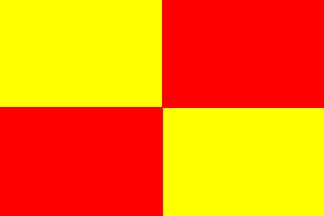 image by Ivan Sache, 10 January 2009
image by Ivan Sache, 10 January 2009
Dr. Jesús Casas Manrique founded "Liceo Infantil"
in 1934 in Bogotá. The institute was renamed in 1937 "Liceo
de Cervantes", as a tribute to the founder's father, Dr.
José Joaquín Casas, who was found of the Spanish culture and,
especially, of the writer Cervantes. The modern grounds of the
institute were built in 1944; in 1949, the founder of the
institute transferred it to Augustinian fathers, only requiring
that the name of the institute would not be changed.
The flag of the institute, as graphically shown and described on
the website
of the institute, is quartered yellow-red, the colours of
Spain and Bogotá.
It appears that the previously reported flag is wrong.
Ivan Sache, 10 January 2009
Previously reported flag
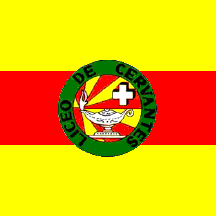 image by Ivan Sache, 9 January 2004
image by Ivan Sache, 9 January 2004
The flag of the College is square, horizontally divided
yellow-red-yellow, with the emblem of the college in the middle.
Source: www.voluntad.com.co>
(defunct), located by Dov Gutterman.
Ivan Sache, 9 January 2004
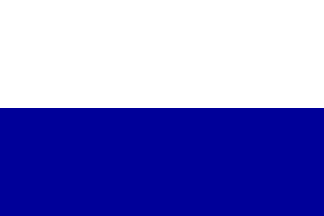 image by Ivan Sache, 01 August 2014
image by Ivan Sache, 01 August 2014
"Universidad CES", founded on 5 July 1977 in
Medellín, was recognized as an university by the Ministry of
National Education on 22 March 2007 (Decree No. 1371).
CES offers programs in Biology, Law, Physiotherapy, Biomedical
Engineering, Medicine, Odontology, Psychology, Veterinary and
Zootechny.
The flag of CES, as described on the CES
website, is horizontally divided white-dark blue. Blue represents
tranquility,
confidence, harmony and the sense of responsibility. White
represents integrity, strength, purity and vigilance.
The arrangement of the colours is not given.
Ivan Sache, 20 December 2008
Photo of the flag:
http://2.bp.blogspot.com/-m2CEUu9HI_I/UV3r8sqb9CI/AAAAAAAAAJ8/74EF49vny_w/s1600/Sala+Universidad+CES.jpg
Ivan Sache, 01 August 2014
 image by Ivan Sache, 5 November 2010
image by Ivan Sache, 5 November 2010
Colegio Cesar Conto, founded in August 1965 in Cali, caters today 1,400
students. The institute is named after the poet and Liberal politician César
Conto (1836-1891), President of the Sovereign State of the Valle del Cauca in
1875-1877.
The flag of the institute is presented on the institute's website as
horizontally divided blue-white. Blue represents justice, perseverance,
vigilance and the sky. White represents, purity, commitment and truth.
Source:
http://www.actiweb.es/colegiocesarconto/pagina4.html
Ivan Sache, 5 November 2010
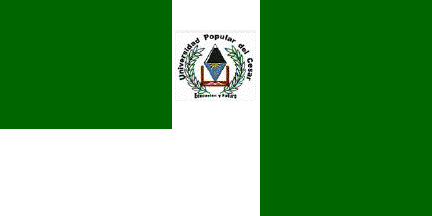 image by Ivan Sache, 01 August 2014
image by Ivan Sache, 01 August 2014
"Instituto Tecnológico del Cesar" (ITUC) was
recognized by the Assembly of the Department of Cesar in 1973
(Decree No. 050) and inaugurated on 15 May 1973. ITUC was
transformed into "Universidad Popular del Cesar" by the
Ministry of National Education on 25 June 1993 (Decree No. 3272).
The main seat of the university is located at Valledupar; there
is a secondary seat in Aguachica and presence in the
municipalities of Chimichagua, Tamalameque and Maicao.
The flag of the university, as shown graphically and described on
the University's website
, is vertically divided green-white (c. 2:1) with a
green stripe in the upper corner and the emblem of the university
in the middle of the white stripe.
The emblem of the university was designed by Jairo Obregón
Salazar, student in Law. It is made of a diamond, black in its
upper part and blue with a yellow sun in its lower part, placed
on a red device, surrounded by two laurel branches. The name of
the university is written in black letters above the emblem,
while its motto, "Educación y Futuro" ("Education
and Future"), is written in black letters under the emblem.
The diamond represents the university, permanently irradiating
light on the vast field of knowledge. Blue represents the
transparency of the sky and the revealed truth, while black
represents darkness and ignorance. The sun recalls Prometheus
stealing a sun ray to show the truth to mankind. Laurel has
always been associated to culture and was also used to crown the
Greek heroes and Roman emperors.
Ivan Sache, 28 December 2008
Photos of the flag:
http://elpilon.com.co/inicio/cesar-diamante-en-oportunidad-productiva-y-exportadora/
http://www.mastigrefr.com/exponen-la-gestion-de-tigre-en-universidades-de-colombia/
Ivan Sache, 01 August 2014